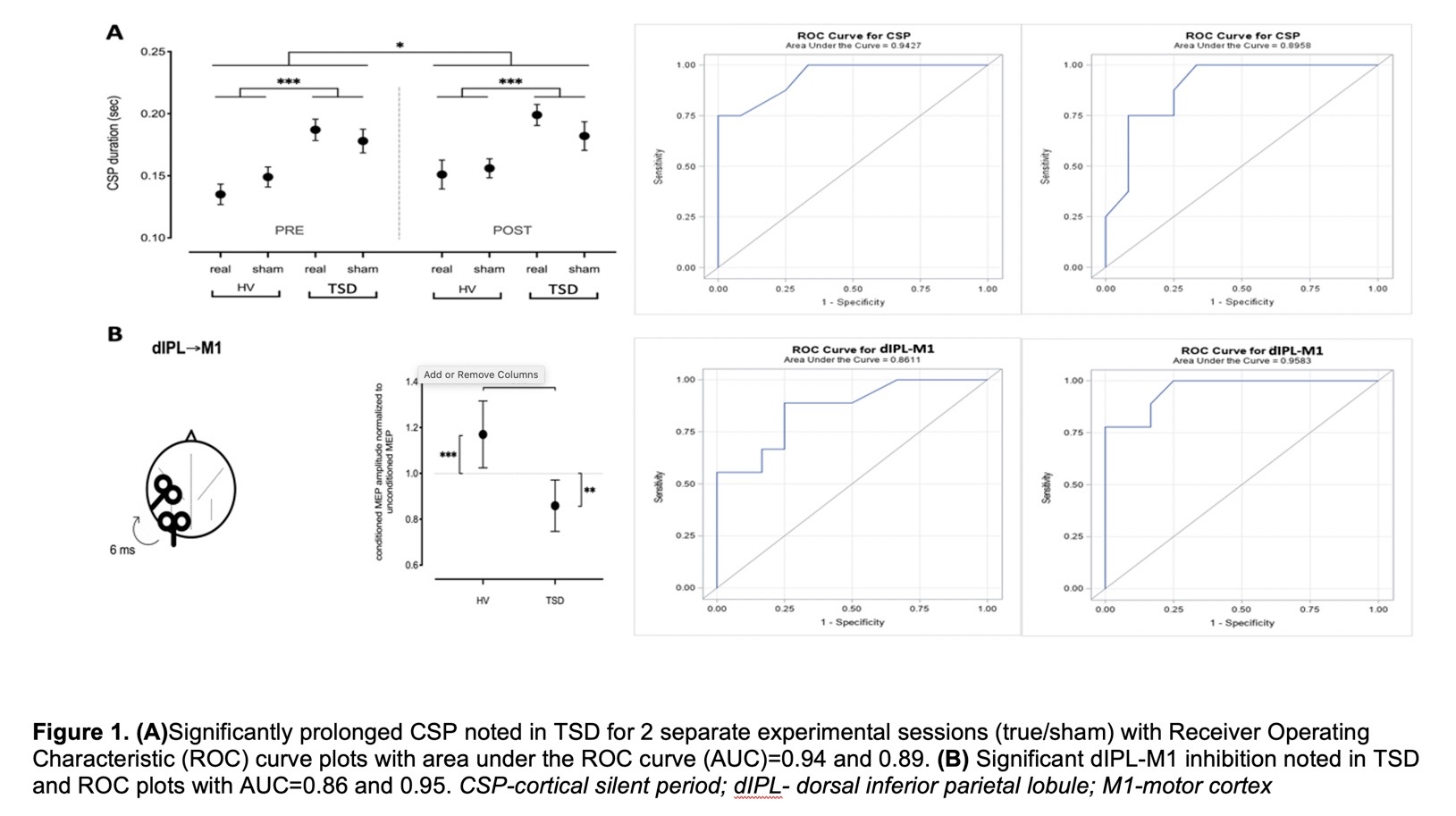Category: Neurophysiology (Non-PD)
Objective: To test the sensitivity, specificity, reproducibility and reliability of two neurophysiologic variables using transcranial magnetic stimulation (TMS) as potential diagnostic biomarkers of task specific dystonia (TSD).
Background: TSD is defined as loss of motor control for a learned and perfected motor skill1, 2. It is challenging clinical diagnosis with a diverse phenotype1-3. Up to 50% of cases are misdiagnosed at the first encounter with diagnostic delays upwards of 10 years with no objective diagnostic biomarkers4-6,7.
Method: Using a personalized approach and standardized methodology, 2 neurophysiologic variables were obtained by TMS; 1. cortical silent period (CSP) and 2. cortico-cortical interactions between dorsal part of inferior parietal lobule (dIPL) and motor cortex (M1); dIPL-M1 interactions8. 9 patients with writer’s cramp (WC) form of TSD and 12 healthy volunteers (HV) (age and sex-matched) underwent testing on 2 separate sessions at least 24 hours apart. The 2 variables were subjected to sensitivity, specificity, reproducibility and reliability statistics to assess their candidacy as potential diagnostic biomarkers for TSD8.
Results: We performed intraclass correlation (ICC) for CSP within the same subjects, with a value of ICC (0.79) suggestive of good reproducibility and reliability9. We used Youden Index to select optimal threshold for sensitivity and specificity analysis for the 2 sessions: For CSP cutoff= 0.178-0.179 msec (sensitivity=75% and specificity= 100%), cutoff=0.148-0.167 msec (sensitivity=100% and specificity=66.67%). Area under the ROC curve (AUC=0.94 and 0.90 for 2 separate session) (Fig 1.A) was suggestive of CSP being a potential reliable diagnostic test/biomarker for TSD using our standardized experimental methodology. dIPL-M1 interaction was notable for motor cortical facilitation in healthy subjects, whereas this interaction was inhibitory in TSD (Fig.1B)8. Using a cutoff= 0.91-0.93 for the baseline dIPL-M1 assessment for the first TBS sessions, sensitivity=77.78% and specificity= 100% and for cutoff=1.04-1.07 sensitivity=100% and specificity=75%. Area under the ROC curve (AUC=0.95 and 0.86 for 2 separate session) (Fig 1.B).
Conclusion: CSP and dIPL-M1 interactions can classify TSD with high sensitivity, specificity, reproducibility and reliability. The relatively low sample sizes for the current study limits generalizability, requiring further assessment in a larger population.
References: 1. Sadnicka A, Kassavetis P, Parees I, Meppelink AM, Butler K, Edwards M. Task-specific dystonia: pathophysiology and management. J Neurol Neurosurg Psychiatry 2016;87:968-974. 2. Albanese A, Bhatia K, Bressman SB, et al. Phenomenology and classification of dystonia: a consensus update. Mov Disord 2013;28:863-873. 3. Pirio Richardson S, Altenmuller E, Alter K, et al. Research Priorities in Limb and Task-Specific Dystonias. Front Neurol 2017;8:170. 4. Defazio G, Esposito M, Abbruzzese G, et al. The Italian Dystonia Registry: rationale, design and preliminary findings. Neurol Sci 2017;38:819-825. 5. Macerollo A, Superbo M, Gigante AF, Livrea P, Defazio G. Diagnostic delay in adult-onset dystonia: data from an Italian movement disorder center. J Clin Neurosci 2015;22:608-610. 6. Powell AT, Bidewell JW, Walker AC. Diagnosing idiopathic dystonia: must it take so long? Aust Health Rev 1995;18:120-131. 7. Valeriani D, Simonyan K. A microstructural neural network biomarker for dystonia diagnosis identified by a DystoniaNet deep learning platform. Proc Natl Acad Sci U S A 2020;117:26398-26405. 8. Merchant SHI, Frangos E, Parker J, et al. The role of the inferior parietal lobule in writer’s cramp. Brain 2020. 9. Shrout PE, Fleiss JL. Intraclass Correlations – Uses in Assessing Rater Reliability. Psychological Bulletin 1979;86:420-428.
To cite this abstract in AMA style:
S. Merchant, M. Hallett. Promising Biomarkers for Task Specific Dystonia [abstract]. Mov Disord. 2021; 36 (suppl 1). https://www.mdsabstracts.org/abstract/promising-biomarkers-for-task-specific-dystonia/. Accessed December 31, 2025.« Back to MDS Virtual Congress 2021
MDS Abstracts - https://www.mdsabstracts.org/abstract/promising-biomarkers-for-task-specific-dystonia/

